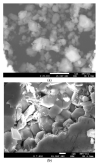Sintering Temperature, Frequency, and Temperature Dependent Dielectric Properties of Na0.5Sm0.5Cu3Ti4O12 Ceramics
- PMID: 34500895
- PMCID: PMC8432498
- DOI: 10.3390/ma14174805
Sintering Temperature, Frequency, and Temperature Dependent Dielectric Properties of Na0.5Sm0.5Cu3Ti4O12 Ceramics
Abstract
NSCTO (Na0.5Sm0.5Cu3Ti4O12) ceramics have been prepared by reactive sintering solid-state reaction where the powder was prepared from the elemental oxides by mechanochemical milling followed by conventional sintering in the temperature range 1000-1100 °C. The influence of sintering temperature on the structural and dielectric properties was thoroughly studied. X-ray diffraction analysis (XRD) revealed the formation of the cubic NSCTO phase. By using the Williamson-Hall approach, the crystallite size and lattice strain were calculated. Scanning electron microscope (SEM) observations revealed that the grain size of NSCTO ceramics is slightly dependent on the sintering temperature where the average grain size increased from 1.91 ± 0.36 μm to 2.58 ± 0.89 μm with increasing sintering temperature from 1000 °C to 1100 °C. The ceramic sample sintered at 1025 °C showed the best compromise between colossal relative permittivity (ε' = 1.34 × 103) and low dielectric loss (tanδ = 0.043) values at 1.1 kHz and 300 K. The calculated activation energy for relaxation and conduction of NSCTO highlighted the important role of single and double ionized oxygen vacancies in these processes.
Keywords: dielectric properties; impedance spectroscopy; sintering.
Conflict of interest statement
The authors declare no conflict of interest.
Figures











References
-
- Wang Y., Jie W., Yang C., Wei X., Hao J. Colossal permittivity materials as superior dielectrics for diverse applications. Adv. Funct. Mater. 2019;29:1808118. doi: 10.1002/adfm.201808118. - DOI
-
- Ramireza A.P., Subramanian M.A., Gardel M., Blumberg G., Lib D., Vogt T., Shapiro S.M. Giant dielectric constant response in a copper-titanate. J. Solid State Commun. 2000;115:217–220. doi: 10.1016/S0038-1098(00)00182-4. - DOI
-
- Subramanian M.A., Li D., Duan N., Reisner B.A., Sleight A.W. High dielectric constant in ACu3Ti4O12 and ACu3Ti3FeO12 phases. Solid State Chem. 2000;151:323–325. doi: 10.1006/jssc.2000.8703. - DOI
-
- Riquet G., Marinel S., Breard Y., Harnois C., Pautrat A. Direct and hybrid microwave solid state synthesis of CaCu3Ti4O12 ceramic: Microstructures and dielectric properties. Ceram. Int. 2018;44:15228–15235. doi: 10.1016/j.ceramint.2018.05.164. - DOI
-
- Jesus L.M., Santos J.C.A., Sampaio D.V., Barbosa L.B., Silva R.S., M’Peko J.C. Polymeric synthesis and conventional versus laser sintering of CaCu3Ti4O12 electroceramics: (micro)structures, phase development and dielectric properties. J. Alloys Compd. 2016;654:482–490. doi: 10.1016/j.jallcom.2015.09.027. - DOI
Grants and funding
LinkOut - more resources
Full Text Sources

